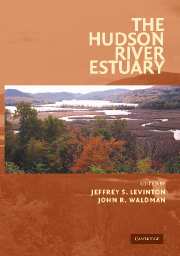Book contents
- Frontmatter
- Contents
- Preface
- List of Contributors
- The Hudson River Estuary
- 1 The Hudson River Estuary: Executive Summary
- GEOLOGICAL, PHYSICAL, AND CHEMICAL SETTING OF THE HUDSON
- PRIMARY PRODUCTION, MICROBIAL DYNAMICS, AND NUTRIENT DYNAMICS OF THE HUDSON
- HUDSON RIVER COMMUNITIES, FOOD WEBS, AND FISHERIES
- CONTAMINANTS AND MANAGEMENT ISSUES OF THE HUDSON RIVER ESTUARY
- 22 The History and Science of Managing the Hudson River
- 23 Hudson River Sewage Inputs and Impacts: Past and Present
- 24 PCBs in the Upper and Tidal Freshwater Hudson River Estuary: The Science behind the Dredging Controversy
- 25 Transport, Fate, and Bioaccumulation of PCBs in the Lower Hudson River
- 26 Contaminant Chronologies from Hudson River Sedimentary Records
- 27 Atmospheric Deposition of PCBs and PAHs to the New York/New Jersey Harbor Estuary
- 28 Toxic Substances and Their Impact on Human Health in the Hudson River Watershed
- 29 Impacts of Piers on Juvenile Fishes in the Lower Hudson River
- 30 Physiological and Genetic Aspects of Toxicity in Hudson River Species
- Index
- Plate section
- References
22 - The History and Science of Managing the Hudson River
Published online by Cambridge University Press: 06 January 2010
- Frontmatter
- Contents
- Preface
- List of Contributors
- The Hudson River Estuary
- 1 The Hudson River Estuary: Executive Summary
- GEOLOGICAL, PHYSICAL, AND CHEMICAL SETTING OF THE HUDSON
- PRIMARY PRODUCTION, MICROBIAL DYNAMICS, AND NUTRIENT DYNAMICS OF THE HUDSON
- HUDSON RIVER COMMUNITIES, FOOD WEBS, AND FISHERIES
- CONTAMINANTS AND MANAGEMENT ISSUES OF THE HUDSON RIVER ESTUARY
- 22 The History and Science of Managing the Hudson River
- 23 Hudson River Sewage Inputs and Impacts: Past and Present
- 24 PCBs in the Upper and Tidal Freshwater Hudson River Estuary: The Science behind the Dredging Controversy
- 25 Transport, Fate, and Bioaccumulation of PCBs in the Lower Hudson River
- 26 Contaminant Chronologies from Hudson River Sedimentary Records
- 27 Atmospheric Deposition of PCBs and PAHs to the New York/New Jersey Harbor Estuary
- 28 Toxic Substances and Their Impact on Human Health in the Hudson River Watershed
- 29 Impacts of Piers on Juvenile Fishes in the Lower Hudson River
- 30 Physiological and Genetic Aspects of Toxicity in Hudson River Species
- Index
- Plate section
- References
Summary
abstract For nearly four centuries humans have been affecting Hudson River resources, with the most profound human influences occurring during the last 150 years. Economic issues have been at the root of most environmental management decisions. Problems and controversies, like dealing with New York City's sewerage, Westway and the Hudson River Power Case, have shaped both regional and national environmental policies. The current intricate matrix of governmental institutions, nongovernmental organizations, and multiple and multidisciplinary issues involved greatly complicates environmental management in the United States. New management structures have emerged to deal with problems that cross political and institutional boundaries, and for which no single entity has full responsibility to resolve. Successes in conquering regional problems have shared the same characteristics: the development of sound technical information to understand the problem and its potential solution; the formation of appropriate partnerships that include all appropriate decision makers; pressure from stakeholders and concerned individuals outside the management agencies for specific outcomes; the acquisition of funds appropriate to the task; and an institutional structure to implement the solution. There is a disconnect between the institutions that fund research and the management agencies that use the information that the funded research generates. With growing demands for watershed planning, habitat restoration, contaminant reduction, and biodiversity protection, agencies will require better understandings of ecosystem processes in order to formulate credible and predictive management strategies.
- Type
- Chapter
- Information
- The Hudson River Estuary , pp. 313 - 334Publisher: Cambridge University PressPrint publication year: 2006
References
- 3
- Cited by



